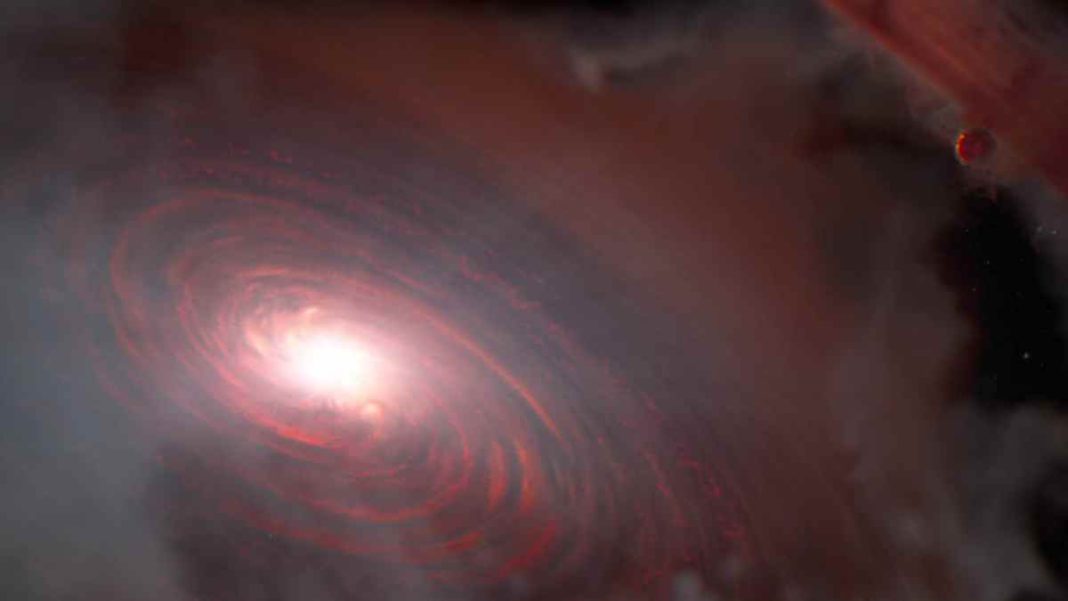UNITED STATES: NASA’s James Webb Space Telescope has made a momentous discovery in the planetary system PDS 70, located 370 light-years away. For the first time, water vapor has been detected in the inner disk of this system, which is known to host two or more young planets.
This groundbreaking revelation marks a significant leap forward in our understanding of how life-sustaining elements, such as water, could be delivered to rocky exoplanets, including our own Earth.
The PDS 70 system is a remarkable sight, comprising both an inner and outer disk of gas and dust separated by an astonishing gap of 8 billion kilometers. Within this intricate setup, two gas-giant planets have already been identified.
The presence of water vapor was detected at a distance of less than 160 million kilometers from the star, precisely in the region where rocky terrestrial planets are believed to form.
Lead author Giulia Perotti from the Max Planck Institute for Astronomy (MPIA) in Heidelberg, Germany, expressed her excitement, stating, “We’ve seen water in other disks, but not so close in and in a system where planets are currently assembling. We couldn’t make this type of measurement before Webb.”
This significant discovery is particularly intriguing as it offers a unique opportunity to study the region where rocky planets, akin to our own blue planet, take shape. The age of the star, PDS 70, is estimated to be around 5.4 million years, which is relatively mature for stars that still possess planet-forming disks.
As time progresses, the gas and dust content within these disks diminishes due to various factors, including radiation and winds from the central star or the aggregation of dust into larger objects that eventually evolve into fully-fledged planets.
While astronomers have yet to spot any planets forming within the inner disk of PDS 70, the presence of raw materials, such as silicates, indicates that the essential building blocks for rocky worlds are indeed present.
The detection of water vapor in this region suggests that, if rocky planets are indeed in the making, they would have access to water from the very beginning of their formation.
The groundbreaking findings raise intriguing questions regarding the origin of the water detected. One possibility is that water molecules are forming in situ, as hydrogen and oxygen atoms unite.
Another fascinating theory suggests that ice-coated dust particles might be migrating from the cooler outer disk to the hotter inner region. There, the water ice would sublimate and transform into vapor.
Further investigations utilizing two additional instruments on the James Webb Space Telescope, namely the NIRCam (Near-Infrared Camera) and NIRSpec (Near-Infrared Spectrograph), are planned to delve even deeper into understanding the dynamics of the PDS 70 system.
These observations were conducted as part of the Guaranteed Time Observation program 1282 and have been published in the esteemed journal Nature.
The James Webb Space Telescope continues to astound the scientific community by unraveling mysteries within our solar system and beyond. Its unrivaled capabilities are providing unprecedented insights into the enigmatic structures and origins of our universe and our place within it.
As we eagerly await further revelations from this extraordinary space telescope, the discovery of water on a young planet in a distant solar system fuels our curiosity about the origins of life and the potential for habitable worlds beyond our own.
The implications of this groundbreaking finding could be far-reaching, offering valuable clues to the origin and distribution of life-sustaining resources throughout the cosmos.
Also Read: NASA’s Hubble Telescope Captures Stunning Images of Asteroid Debris Resulting from DART Impact



